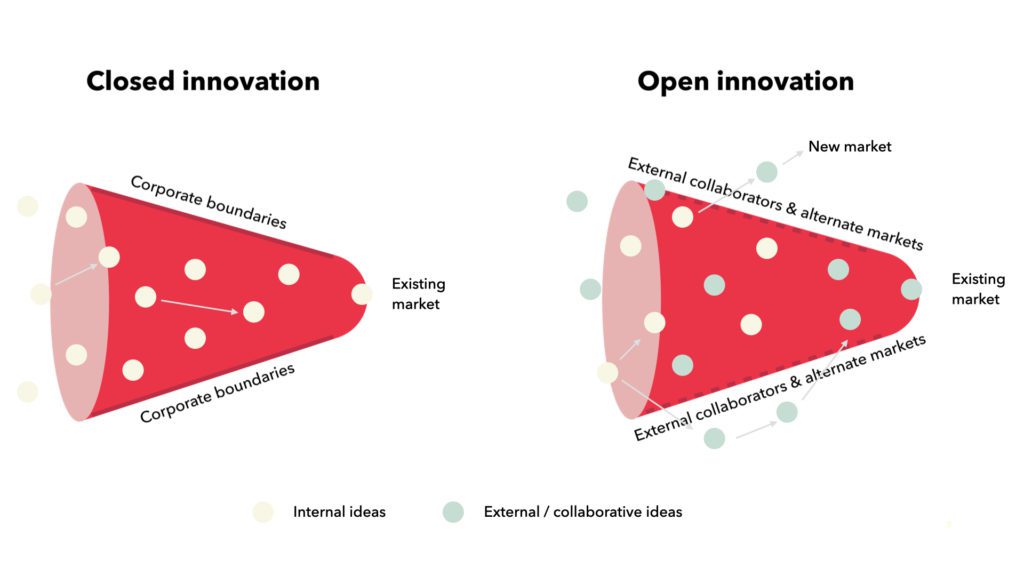Contrary to common belief, open innovation is not only about collaborations between big companies and startups. It’s about leveraging partnerships based on when in the funnel time-line they come into place.
First steps towards Open Innovation
Regardless if it’s startup safaris or running proofs of concept; financial resources could be drained before a partnership is even in place. At the same time, credibility can suffer multiple blows unless partnering is internally and externally monitored as part of this strategic process.
Yes, open innovation collaborations may involve startups; but it also sets the ground for scale-ups, established partners, other types of institutions, and even competitors. Any partnership will be influenced by where in the project funnel the collaboration is formed. Whether it is as early as the problem discovery phase, or at the end towards validation and launch. So, what does this mean?
It means that an open innovation strategy achieves impact through the development of relevant connections; these are the ones that get real-world results. Ideal as it may sound, opening up to a partnership leads to a dire need for new strategies, and even a mindset shift on what open innovation is.
Below are two important steps to consider in your journey towards successful partnerships through open innovation.
CHECK YOURSELF
Knowing the pain-points and strengths of your own organization is the first step to set thriving collaborations in motion. Not only from a strategic, but a technical, financial and value-based perspective.
Although a detailed strategy plan starts with knowing your own strengths and gaps, the actual step forward comes when companies realize exactly what it is they need to know about themselves.
In order to enter a partnership, which department should be approached first? How should they be approached? The answer to all key questions, the way pilots are set up, and the overall strategy. It will all depend on being able to recognize what you need to know about your organization.
New ways of working, connecting, and communicating will restructure the mechanism that makes external collaborations withstand the speed of evolving ecosystems. However, even after setting the right parameters for yourself, there is still a lot of ground to cover. For example, the B2B sector has progressed in such ways the success doesn’t rely solely on strong deals, but a new perspective on open innovation overall, one that expands the limits of what the partnerships can achieve.
BEYOND COMMON SENSE
Collaborations are a two-way street. Both partners will enter not only a collaboration, but the opportunity to learn, while at the same time offering and receiving groundbreaking perspectives. However, an abundance of information doesn’t make open innovation partnerships fall into place.
The approaches should be simple, but that doesn’t make them obvious. The goal of having a strategy is not only to help collect relevant data and assess risk but to develop a solid and flexible plan that doesn’t leave key aspects behind and that can adapt to its context.
Essential information is achieved by asking the right questions. What are the requirements for a partnership to work? Even if our mission is aligned, how can we make sure such collaborations are long-lasting? Which are red or white flags when risk-assessing potential partners? An innovation strategy will aid in determining the right questions and will help come up with the answers.
Why should B2Bs look at open innovation strategies?
By pushing aside limiting open innovation concepts, a re-signified open innovation strategy broadens the horizons for potential collaborations, and it can make the most of exploiting their internal and external resources. Through investments, partnerships, acquisitions, and accelerators, open innovation boosts the innovation agendas of organizations, and it does it tailor-made.
Ranging from research and development, to focusing on specific products and solutions; the possibilities may appear to be endless. Innovation strategies narrow down the possibilities, simplify complicated sets of information, and speed up the innovation process.
By connecting the right data, open innovation strategies create long-term partnerships that look to make a positive impact at a larger scale, improve, and accelerate the approach to validated results. They go beyond what’s good enough by finding more scalable and even unexpected possibilities.
Why should an open innovation strategy be in place?
Think of information as a waterfall. Open innovation strategies make sure the water is filtered out until it turns into a stream. Your innovation strategy will be this filter. A partnership that follows no plan will have the opposite effect.
But, filtering and setting the right data in place is not the only reason why open innovation strategy should be in place. So what is the reason? Innovation strategies need the right information to be set in motion, but they’re not a linear plan with steps to follow.
Innovative strategies have the ability to move forward as the strategy itself develops. It is a way of learning while doing, and doing to validate solutions. Plans for efficient problem solving, product or service launches, and new ways of thinking, are all to be living structures that grow as they go.
GENERAL RULES DON’T APPLY
But, open innovation is more than marrying companies based on data and common goals. Although information is the base, without an innovation strategy in place, an investment can take a wrong turn.
When general rules don’t apply, a custom-made plan is necessary. Why? Because the personality of a business will be one of the cornerstones of a successful collaboration. Just like each company, every partnership should be unique. A template-like approach will only get you so far, this is where the strategy comes in.
Unseemingly, a great number of companies walk down this road without a clear overview on their validated options. A good open innovation strategy will be flexible enough to adapt not only to context, but to the strengths and gaps of each partner.
MURPHY’S LAW: TACKLING PROBLEMS BEFORE THEY SHOW UP
Open innovation strategies also lead to success by tackling a partnership’s crucial requirements. Their job is to create flexible solutions when the potential future obstacles are virtually unknown. The only way to tackle the unknown is by strategies that learn while being executed.
Partnerships that don’t reach their goals tend to have a common denominator: a lack of consistency. The best results are not born from a linear plan and a bundle of information; they thrive on strategies that pivot their way around potential challenges based on validated facts.
Making it matter
Innovation strategies are not a trend, but a mindset. They are fueled by relevant knowledge, and thrive on their capacity to constantly adapt to a fast paced and ever-evolving internal and external market. As the requirements shift, so do solution strategies to be applied.
The rapidly changing B2B industry has led to the need of innovation strategies, to make sure partnerships are up to date with how fast and vastly business fields intersect. Looking outside one’s core industry is not only relevant, it’s a need. How does your organization look at open innovation? Which strategies have you pushed to activate the power of collaboration?
Tell us below, we’d love to hear about your experiences!
Reference: https://www.boardofinnovation.com/blog/how-to-approach-open-innovation-strategy/

